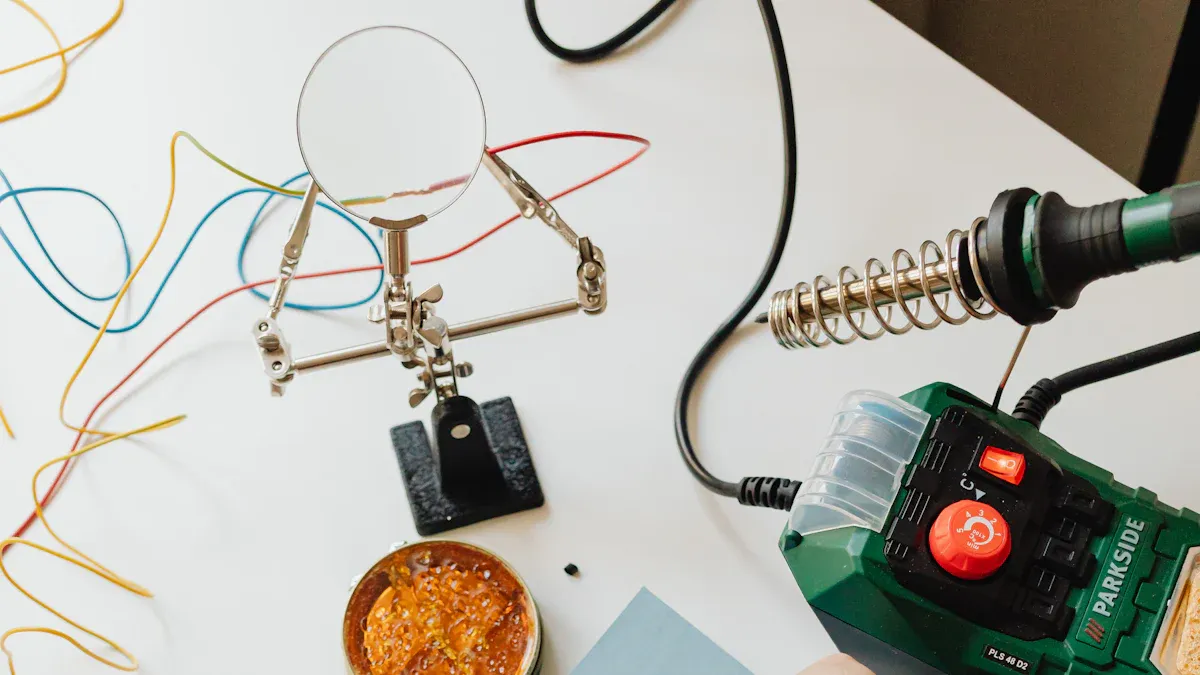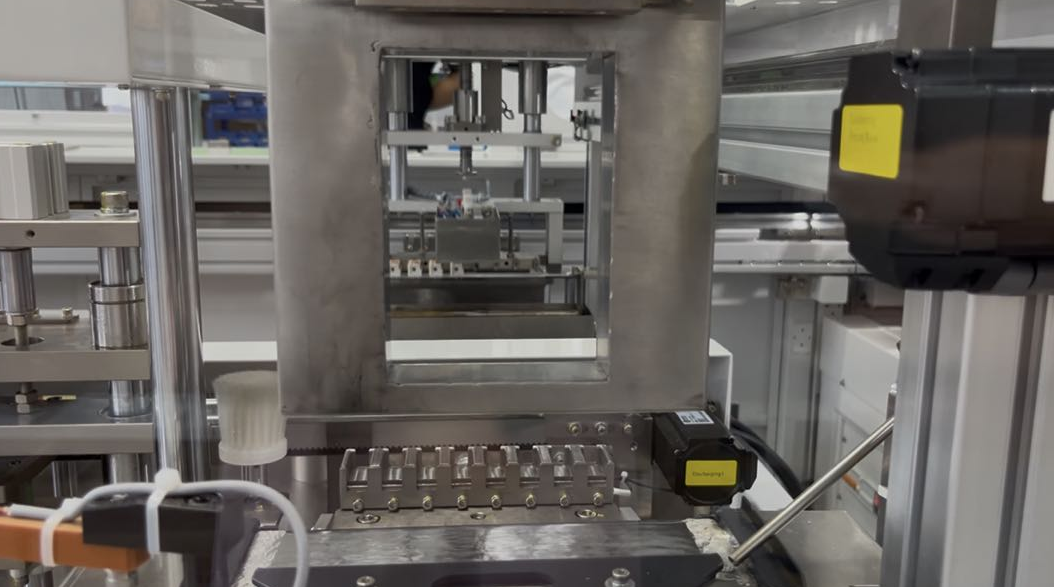
SIPU: Fueling Soldering Machine Rise with Precision & Automation
2025-09-17 14:46Soldering machines are reshaping the way industries join and connect metal parts. From small consumer devices to large automotive systems, these machines provide the precision, reliability, and efficiency that modern production demands. As the global market continues to shift toward intelligent manufacturing, soldering machines are becoming indispensable tools across sectors such as electronics, automotive, appliances, renewable energy, and precision coil winding.
A soldering machine makes strong connections that last a long time. It is easy to use, works well, and is important for your devices.
Key Takeaways
A soldering machine connects metal parts by melting solder, creating strong, long-lasting bonds.Widely used across industries—including automotive, electronics, and plumbing—it supports both assembly and repair work, while boosting efficiency and simplifying project completion.
There are three main types of soldering machines: manual, semi-automatic, and automatic, each suited to different tasks and skill levels. Precision is key, especially in electronics, as these machines ensure neat, accurate joins.
Safety is essential when operating soldering machines: always wear safety gear and keep the workspace tidy. For versatility, they’re applied in hobbies, repairs, and factory production alike. To maintain performance and strong bonds, regular tip cleaning is recommended.
1. Soldering Machine Definition

What Is a Soldering Machine?
How It Works
1. 1 Melting Solder
First, turn on the soldering machine and set the correct temperature. The soldering iron heats up rapidly—once ready, touch its tip to the solder wire, which melts immediately. The molten solder then flows onto the metal parts you intend to join.
1.2 Joining Metals: Step-by-Step Process
Crucially, molten solder doesn’t just “stick” to metal—it dissolves a tiny layer of the metal surface and fuses with it, creating a chemical bond. This results in a solid connection that either conducts electricity (for electronics) or keeps parts securely joined long-term.
1.3 Pro Tip & Machine Advantages
2. The Versatile Uses of Soldering Machines

Electronics Assembly
A core tool for electronics—joining tiny parts in phones/laptops and ensuring reliable circuit boards (used in cars, hospitals, factories). It also connects thin wires to keep signals flowing, with precise control for repairs.
Circuit Boards
A soldering machine can use for circuit boards. Circuit boards are important in electronics, such as in phones, cars, factories, and hospitals.
Wiring
Soldering machines connect wires inside devices. This keeps signals moving and powers your gadgets. You can join thin wires without hurting them. Soldering machines stop wires from coming loose.
Automotive Repairs
Soldering machines are important for fixing cars to repair metal parts and wires. When you fix a car, you want strong connections.
Metal Parts
To solder car wires effectively, follow this streamlined process:
Manufacturing
Factories worldwide depend on soldering machines for efficient, high-quality production, and Xiamen Sipu Mechanical stands out as a professional provider in this field. Its soldering machines—equipped with precise digital control systems and servo motors—enable accurate programming of key parameters (like dipping depth and temperature) to suit diverse tasks (from transformers to relays). They also feature practical functions such as automatic solder dross cleaning, ensuring strong joints and durable products. This blend of precision, versatility, and reliability lets factories boost production speed while maintaining quality, solidifying Xiamen Sipu Mechanical’s reputation in the industry.
Sheet Metal Fabrication
Soldering machines are indispensable for sheet metal work, letting you join metals like copper, brass, iron, silver, and gold without heavy welding gear. They’re perfect for electrical connections and non-structural joins—for example, linking electrical components on circuit boards, connecting plumbing copper pipes, crafting silver/gold jewelry, or building brass/copper musical instruments. You’ll get clean, precise joins that won’t damage delicate materials, making the machine ideal for custom metal signs or repairing musical instruments, even when handling small parts or thin sheets.
Keep in mind that soldering machines work best for non-structural connections; thick steel beams need welding tools instead. Still, for plumbing and sheet metal projects, they simplify work significantly—saving time, avoiding mess, and ensuring professional, long-lasting results every time.
3. Types of Soldering Machine
When you look for the right soldering machine, you will find three main types: manual, semi-automatic, and automatic. Each type fits different jobs and skill levels. Let’s break them down so you can see which one matches your needs.
Manual
Manual soldering machines give you the most control. You hold the tool and guide every move. This type works best for small projects, repairs, or when you need to be extra careful.
Soldering Iron
A soldering iron is simple and easy to operate: just plug it in, wait for it to heat up, then touch the tip to the metal and solder. It’s ideal for tasks like prototyping new gadgets, fixing broken wires, and making small batches of products—you control the amount of solder used and its placement, which makes it perfect for delicate, precise work.
Soldering Gun
A soldering gun, pistol-shaped and fast-heating, starts with a simple trigger pull—ideal for tasks that need speed or extra heat, like quick repairs, connecting thicker wires, small-batch runs, lab work, and rework. As a manual tool, it lets you adjust on the fly, fix mistakes instantly, and offers flexibility that automated machines can’t match.
Semi-Automatic
Semi-automatic machines help you work faster and more accurately. You still control some steps, but the machine handles the tricky parts.
Soldering Station
A soldering station gives you a base with temperature controls. You can swap out tips and set the heat just right. This helps you make neat, repeatable joints.
Wave Soldering
Wave soldering uses a wave of melted solder to join many parts at once. You place your board on a conveyor, and the machine does the rest. This method works well for medium-sized batches.
Here's a quick look at the pros and cons:
Automatic
Automatic soldering machines do almost everything for you. You set them up, and they handle the rest. These machines shine in big factories.
Robotic Systems
Robotic systems use arms and sensors to solder parts with high speed and accuracy. You can trust them to make the same joint over and over with no mistakes.
Reflow Soldering
Reflow soldering heats entire boards in an oven. The solder melts and connects all the parts at once. This method is great for mass production.
Check out how automatic machines boost your results:
If you want speed, accuracy, and fewer mistakes, automatic machines are the way to go.
4. Benefits of SOLDERING MACHINE
Soldering machines are essential for efficient, high-quality work, with key advantages for all users:
Efficiency & Precision
Heats up in seconds to speed up tasks (e.g., circuit board batches) and cuts rework. For delicate jobs (electronics, medical tools), it controls heat/flux precisely—automated or selective systems ensure neat, error-free joins.
Consistency & Safety
Delivers uniform joins every time (critical for trust in work).
5. Soldering Machines in Modern Industry
Soldering Machines are essential in automation, electronics, automotive, and manufacturing. They deliver precision, speed, and reliability for mass production.
Electronics
Used for circuit boards, smartphones, and computers. Automated systems with robots and AI ensure high quality and fewer defects.
Automotive
Critical for ABS coils, sensors, and control units. Automated soldering provides safe and stable connections that meet strict industry standards.
Manufacturing
Factories use Soldering Machines with flexible nozzles, closed-loop control, and automated feeding to handle different products efficiently.
Key Benefits
Precision – accurate joins for better performance
Reliability – strong and lasting connections
Automation – faster, smarter, cost-effective production

FAQ
What is a SOLDERING MACHINE used for?
A Soldering Machine is used to join metal parts by melting solder. It is widely applied in electronics, circuit boards, automotive components, and plumbing. From small repairs to large-scale industrial production, it ensures precise, strong, and reliable connections.
How do you clean a SOLDERING MACHINE tip?
Clean the tip regularly with a damp sponge or brass wire cleaner. This prevents oxidation, keeps heat transfer efficient, and ensures strong solder joints. A dirty tip can lead to weak connections and poor performance.
Is a SOLDERING MACHINE safe for beginners?
Yes, if used correctly. Beginners should wear gloves and goggles, avoid touching the hot parts, and keep the workspace tidy. Following proper guidelines makes the Soldering Machine safe and easy to use.
What types of Soldering Machine are available?
Pick the type that fits your needs.
Manual Soldering Machines – best for small jobs and DIY.
Semi-automatic models – suitable for medium-volume production.
Automatic Soldering Machines – widely used in electronics factories, automotive, and manufacturing for high efficiency and consistency.
Why does SOLDERING MACHINE need flux?
Flux improves soldering quality by cleaning metal surfaces, preventing oxidation, and allowing solder to flow smoothly. Using flux with your Soldering Machine ensures stronger, more durable joints.
